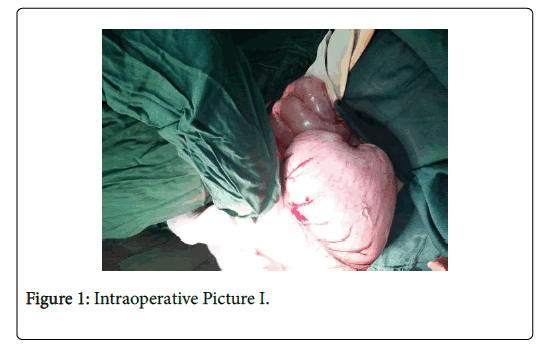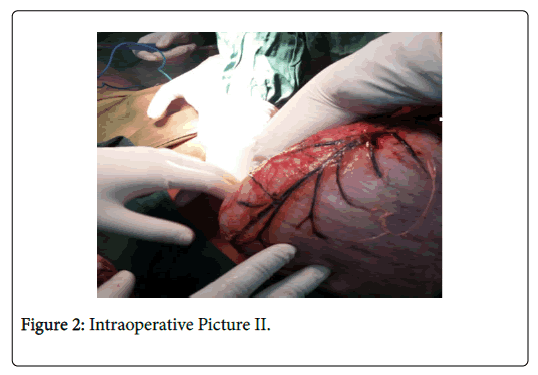A Case Report on Acute Abdominal Compartment Syndrome 2NRY to Acute Gastric Dilatation
Received: 06-Sep-2018 / Accepted Date: 16-Oct-2018 / Published Date: 26-Oct-2018 DOI: 10.4172/2472-1220.1000576
Keywords: Acute abdominal compartment syndrome; acute massive gastric dilatation; MOF 2ry
Introduction
Abdominal compartment syndrome is a breakdown in circulation due to the elevation of pressure in a limited anatomic region, and therefore blood rushes the tissues, making a negative effect on the functionality of the organs [1-2].
In etiopathogenesis peritonitis, perforation and acute stomach dilatation are the reasons to be attributed [3-5]. Acute Gastric Dilatation (AGD) was first described by Duplay in 1833 [6]. Acute Massive Gastric Dilatation (AMGD) which is quite rare represents the extreme form of AGD [7]. When the stomach is extremely distended occupying the abdomen from diaphragm to pelvis and from left to right, the AGD is referred to as AMGD. Dilatation is triggered by the vicious cycle of elevation in gastrin secretion due to stretched antrum and stomach secretion, which is elevated due to gastrin secretion [8-9]. In this case report the presence of dyspeptic symptom was for around 1 year, though due to socioeconomic reason the patient was not having endoscopic diagnosis and any ulcer treatment [10]. Therefor severe presentation of abdominal compartment syndrome has mortality between 71%-85% [11,12]. So early clinical diagnosis and treatment of such case is very important and as well to report it has good academic importance for future management principles [13].
Case Presentation
History
A 45 years old man presented to the emergency department with sudden onset of abdominal distention which started 10 hrs back. He had also 2 episodes of non-bilious vomiting and central aching abdominal pain. He had symptoms of epigastric dyspepsia for more than 1 year, associated with spicy feeding but was not on any type of anti-ulcer medication.
He didn't pass flatus and feces and urine after his complaints. He had no history of chronic illness like Diabetes Mellitus (DM), Hypertension (HTN), Respiratory Virus Infection (RVI) or any psychiatric illness. We witnessed one episode of tonic colonic type of seizure involving upper and lower extremities with uprooting of the eyes, drooling of saliva.SS
Physical examination
• General anaesthesia: Acutely sick looking
• Blood pressure: Unrecordable
• Per rectum: fible, Respiratory rates-34
• Temperature=35°C, PaO2=75, on facemask O2-85%-90%
• Head, eye, ear, nose, and throat: pink conjunctiva, non icteric sclera, nasogastric tube tube in situ -no output
• Lennox-Gastaut syndrome: no leukocyte alkaline phosphatase
• Chest: Clear and good air entry
• Abdomen-grossly distended board like abdomen, hypertympanic to percussion
• Per rectum: Protruded out rectum obliterating the anal canal, difficult to insert a finger
• Genitourinary system: Ejaculated semen around the urethral orifice, catheter in situ, and no urine output
• Multiple sensory stimulation: no skin lesion, no edema
• Central nervous system: conscious and oriented, no motor deficit
Investigation-Hg 12 mg/dL, blood group: O+, erect abdominal filmsignificantly dilated Stomach with single air fluid level; there is no air under the diaphragm. Resuscitation started on double IV line and laparotomy done.
Inspection Observation Finding [IOF]: There was gush of air and around 100 mL of serous fluid with pressure upon opening the abdomen, with significantly dilated stomach from the diaphragm reaching to the pelvis and partly volvulated anti clockwise. There was perforation around 2.5 cm at the greater curvature posteriorly 2 cm from the pylorus but there was no content leaked to the peritoneum until decompression done due to slight volvulus and was contended in the lesser sac (Figure 1). There was serosal tear on the greater curvature anteriorly and thinned out gastric wall.
Small bowels were collapsed, dusky and patchy darkening of ileum on anti-mesenteric side at 2 sites initially then progressively developed at multiple sites of ileum and jejunum. The rectum and sigmoid colon were collapsed. The other part of viscera seems okay grossly (Figure 2).
Discussion and Conclusion
Immediate laparotomy and decompression done then suctioning of serous and gastric content done and gastric perforation repaired and biopsy taken. After that to shorten the anesthesia time thorough peritoneal lavage done and drain left at lesser sac and abdomen closed with only skin considering relook after optimization. Intraoperatively his BP was 80/40, despite he is on dopamine drip at 5 ug/k/min at max drop, and 2 units of crossed matched whole blood transfused he couldn't awake from anesthesia and died after 4 hrs of stay on table with possible cause of death. Multiorgan failure 2ry to acute abdominal compartment syndrome 2ry to acute massive gastric dilatation and Reperfusion syndrome.
Conflicts of Interest
The authors have no conflicts of interest.
References
- Paimela H, Joutsi T, Kivilioto T (1995) Recent trends in mortality from peptic ulcer disease in Finland. Dig Dis Sci 40: 631-635.
- Schein M, Wittman DH (1996) The abdominal compartment syndrome following peritonitis, abdominal trauma and operations. Complications in Surgery 15: 1-10.
- Ivatury RR, Diebel L, Porter JM, Simon RJ (1997). Intra-abdominal hypertension and the abdominal compartment syndrome. Surg Clin North Am 77: 783-800.
- Kron IL, Harman PK, Nolan SP (1984) The measurement of intra-abdominal pressure as a criterion for abdominal re-exploration. Ann Surg 199: 28-30.
- Meldrum DR, Moore FA, Moore EE, Franciose RJ, Sauaia A, et al. (1997) Prospective characterization and selective management of the abdominal compartment syndrome. Am J Surg 174: 667-672.
- Tiwari A, Haq AI, Myint F, Hamilton G (2002) Acute compartment syndromes. Br J Surg 89: 397-412.
- Farag S, Fiallo V, Nash S, Navab F (1996) Gastric perforation in a case of gastric volvulus. Am J Gastroenterol 91: 1863-1864.
- Lunca S, Rikkers A, Stanescu A (2005) Acute massive gastric dilatation: Severe ischemia and gastric necrosis without perforation. Rom J Gastroenterol 14: 279-283.
- Flores AE, Avila GE, Gonzales GE, Rivera BE, Lopez JL, et al. (2005) Early diagnosis and risk factors associated with abdominal compartment syndrome. Cir Cir 73: 179-183.
- Jefferiss CD (1972) Spontaneous rupture of the stomach in an adult. Br J Surg 59: 79-80.
- Adson DE, Mitchell JE, Trenkner SW (1997) The superior mesenteric artery syndrome and acute gastric dilatation in eating disorders: A case report of two cases and a review of the literature. Int J Eat Disord 21: 103-114.
- Todd SR, Marshall GT, Tyroch AH (2000) Acute gastric dilatation revisited. Am Surg 66: 709-710.
- Turan M, Sen M, Canbay E, Karadayi K, Yildiz E (2003) Gastric necrosis and perforation caused by acute gastric dilatation: Report of a case. Surg Today 33: 302-304.
Citation: Yesewbelay Minale (2018) A Case Report on Acute Abdominal Compartment Syndrome 2NRY to Acute Gastric Dilatation. J Gastrointest Dig Syst 8: 576. DOI: 10.4172/2472-1220.1000576
Copyright: © 2018 Minale Y. This is an open-access article distributed under the terms of the Creative Commons Attribution License, which permits unrestricted use, distribution, and reproduction in any medium, provided the original author and source are credited.
Select your language of interest to view the total content in your interested language
Share This Article
Recommended Journals
Open Access Journals
Article Tools
Article Usage
- Total views: 4552
- [From(publication date): 0-2018 - Oct 13, 2025]
- Breakdown by view type
- HTML page views: 3615
- PDF downloads: 937


